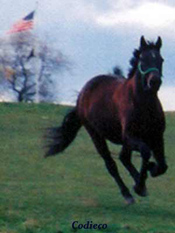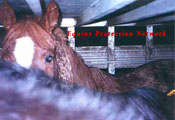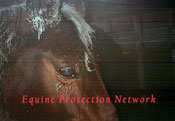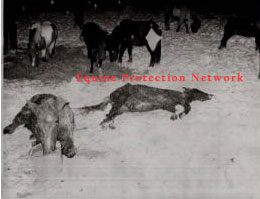
Shop for CD's at CDRush.com & the EPN Benefits!
Put "EPN" in the Coupon Code box when you place your order.
Now you can save money on your favorite music and help the horses at the same time!
EPN Website Sections
Press Stories 1980-2004
The Final Roundup Pittsburgh Magazine 5 /2004
Fighting to Stop the Sale & Slaughter of US Horses in Foreign Countries - KDKA TV Investigates 4/30/2004
The Slaughter Question Horse & Rider 12/2002
State Ranks High in Equine Slaughter WTAE's Paul Van Osdol Reports 4/27/2001
Slaughterhouse Ride WISH TV News 8 I-Team Investigative Report 4/2001
Illinois Defeats Horse Slaughterhouse! 1999
Kill Sale Pittsburgh Post Gazette 6/ 1999
Horses To Slaughter
Police, vet check horses' health at New Holland sale
July 1998
PA Horse Transport Legislation - Act 64 of 2001
Horse Transport Bill Passes Unanimously WTAE's Paul Van Osdol Reports 6/21/2001
State Lawmakers Urged to Protect Horses en route to Slaughterhouses
June 1998
State Concerned with Cruelty to Horses Taken for Slaughter
'TRAIL OF TORTURE' ?
June 1998
Horse-Slaughter Industry Critics Pushing Changes
PA. Bill Would Help Protect Horses Headed to Slaughter
March 28, 1998
The goal is a humane trip for horses on the way to be killed for their meat, prized in Europe.
New York Does PA's Dirty Work January 1998
NYSP Stop Double Deck Trailer

Horses inside double deck cattle trailer stopped by the NYSP. The owner was later convicted & fined $3000.00.
Horse Popsicle Case 1994
Cruel Transport Results in $11,100 Fine

Horses inside double decker covered with frost.
The Last Ride
Eyewitness Account of trip to Slaughterhouse
Overcrowding, negligence plague Shelby horse feedlot
Great Falls Tribune 8/10/2003
The Torture Trail
December 1980
85 horses in trailer, 57 survive

A dead horse lies in the snow, while another too weak to rise eats from a bucket.
The Miracle Mile July 1990
Pregnant Mare Foals Hours After Rescue From Slaughterhouse-
Foal is a Stakes Winner!
 Pasturemate of the Stakes Winner, "On Route 66" who was born only hours after her dam was taken from a slaughterhouse
Pasturemate of the Stakes Winner, "On Route 66" who was born only hours after her dam was taken from a slaughterhouse
PA Dealer Sent to Prison 1999
Shady Horse Dealing
Renaissance Bob 12/ 1998
Rescue of a Racehorse
An Eye For An Eye
Story of Catch-22

Links
California Voters "Just Say Neigh" to Horse Slaughter!
HoofPAC
Shop online at IGive.com with over 600 great stores you know & love- including Back In the Saddle! Up to 26% of the purchase price is donated to the EPN!
The EPN gets $5 extra the first time you shop!
PayPal accepts credit cards! Please send your tax deductible donation to the:Equine Protection Network, Inc.,
P. O. Box 232, Friedensburg, PA, 17933.
HoofPAC is the political action committee that has been formed to end the slaughter of America's horses. Cathleen Doyle, founder of HoofPAC, led the successful Save The Horses campaign in 1998 that made the slaughter of California's horses a felony.
"This is an important issue and we have to start doing the right thing. I'm not just talking about racetracks, but owners and breeders. Everyone who is involved in this industry has an obligation to the animal. We sell to the public the beauty of the horses and the love that we have for them and how that's a critical element of this sport. We then can't let this happen to these horses." ...
Hal Handel, Philadelphia Park CEO
Page last revised on:

AN EYE FOR AN EYE
. . . led amateur hunter rider Leigh Berman and her trainer, John Muldoon, to a racetrack reject with the talent to compete at the top.
Reported by Jessica Reffier
as printed by Practical Horseman

Hundreds of horses and ponies - some sound, some sore, many crippled - stood crowded in row and pens at the New Holland, Pennsylvania, livestock auction that first Monday in August 1992. Many would soon sell by the pound to pet-food companies. But one painfully thin ex-racehorse standing quietly among other track rejects, Amish carriage horses, and former back-yard pets caught amateur hunter rider Leigh Berman's eye. She and her trainer, John Muldoon., bid for him against the pet-food companies and took him home for less than a thousand dollars. With two years of teamwork and persistence; they qualified the horse, Catch 22 ("Cappie" at home) for Devon and the indoor shows - and pinned at both.
Leigh - a full-time Temple University student with a shallow pocketbook but a depth of riding ability that had earned her respectable ribbons at local shows and John's trust with young horses at his barn- arrived at New Holland with John about midmorning. Their goal: finding a young Thoroughbred Leigh might take to the three-foot amateur hunter division. Avoiding eye contact with horses already marked for the slaughterhouse, Leigh walked the six-foot-wide aisles between rows of horses tied to any available solid object - pipe fencing, wood fencing, posts in no particular order. John, like other experienced buyers, ducked in and out of the rows, patting neck, feeling legs, and talking to the few dealers he'd come to trust over the years. He found one horse for another client and a dark bay Thoroughbred he liked for Leigh.
Meanwhile, though, Leigh had spotted a chestnut gelding tied to a pipe. "I just turned my head and he was there. Something in his eye told me, -'This is the one."' What drew Leigh to Cappie was the same quality John uses to begin sifting through the renegades, the crippled, and the ordinary at New Holland, where he frequently goes to find affordable horses for clients. 'It's not my eye that matters he says. "It's theirs. You can tell by looking at a horse's eye if he's mean, scared, or in pain - if he's a good soul. I like a big, soft, kind, round eye, like a doe's. Cappie has that eye. And that's what Leigh saw when she found him." After Leigh pointed out the gelding. John curled back Cappie's upper lip and found a Jockey Club tattoo begining with "R." That meant the horse was born in 1988 and was four now. John carefully ran his hands down Cappie's legs to check for bumps and swelling. ("'I can live with a splint or even a bowed tendon, so long as it's not big and ugly") But all four legs were clean. That first test passed, Leigh untied Cappie from the pipe and led him to a wider aisle around the corner. There John stepped back to look at the gelding and found that even though Cappie had no muscle and a pencil-thin neck, he looked balanced, his shoulder sloped well, and his legs were well conformed. Next, John watched as Leigh. weaving between piles of manure and other horses, jogged the gelding away and back. He looked sound and, for a horse with no muscle, moved the way a hunter should, with little break at the knee, though his stride seemed a bit short and tentative. "'He was probably muscle sore, which didn't bother me." John remembers. 'Racehorses who pound the track every day are bound to feel achy, the way a quarterback who got sacked five times on Sunday will on Monday morning. They just need to recuperate. But I pass up a horse who's head bobbing lame, no matter how much I like his eye." John flexed the gelding's legs to test for joint mobility, if a horse won't flex, there's no way he'll stand up to training" -and had Leigh jog him off again to see if any latent lameness appeared, again, Cappie passed. 
Leigh returned the gelding to his pipe and tied him back up. She patted him and noted the number pasted on his hip, which the loudspeaker would announce when he was about to be auctioned. In the bleachers overlooking the auction block, John reminded Leigh that even though the gelding had jogged sound, she'd be taking a chance - as John does with every horse he buys at New Holland - that the horse had been tranquilized or injected with anti-inflammatory drugs to disguise lameness and swelling. ("I give horses a week," John says,- If they're unmanageable or lame, they go back. But out of twenty-five I've bought at New Holland, I've only sent back three. Two had bone chips in their knees and one had a bad ankle, as we found when the injections wore off.") Besides, though John liked Cappie, he wanted Leigh to consider the fancier bay. Leigh, however, had eyes only for Cappie. She finally persuaded John to go along.
As trainer and student had agreed, John, with more experience and less emotional involvement, did the bidding. Leigh's heart skipped a beat every time the pet-food companies upped their bids. but thev didn't answer when John offered $680. Cappie was hers. Late that afternoon, in the outdoor ring back at his Reinbow's End Farm in Glenmoore, Pennsylvania, John gave Leigh a leg up on Cappie. As her seat touched the saddle, her new horse trotted off and bucked - but Leigh, who'd dealt with John's ex-racehorse "finds" before, sat up and stopped Cappie, then walked him until he calmed. Next she trotted and cantered him; watching, John saw a decent trot and an even better canter, especially for a green horse. To see if Cappie could jump, John set a couple of two-foot fences. The horse didn't want to come within five strides of them - "he was a big chicken at first." Leigh remembers. But she coaxed him over both fences with encouraging pats and lots of leg, and he jumped round and brought his knees up fairly well. At that point, John thought Cappie would make a three-foot adult-amateur horse. 'Being so scruffy and uneducated, he didn't look fancy enough to do the three-six divisions at A shows. Besides, you just don't bring a horse home from New Holland with high expectations." Leigh was surer: "We just clicked. Even though he tried to take off bucking, I loved him. And after that, he moved off my leg and went on the bit. It was as if he already knew."
After Cappie's week of probation and a clean set of x-rays, Leigh decided to keep him. She had him dewormed and immunized and had his teeth floated, while John put him on a generous feeding program to fatten him. Leigh spent the next two months working Cappie and playing with him. On the flat, she taught him shoulder-in, haunches-in, counter-canter, and other lateral exercises. Over fences, she still had some spookiness to deal with at first, but as soon as he learned the jumps wouldn't hurt him, he jumped around. John got on only if Leigh was having trouble: "If Cappie pulled her around a little, I could put him together with my leg and back him off my hand; then he'd be good for her."
As Cappie settled in and began gaining weight, he became the "bad boy" around the barn, pulling things off walls and blankets off his nineteen year old pasture mate, Noble Z ("retired" from amateur hunters to the ladies' sidesaddle division when John turned professional).
In October, after Cappie had learned to walk-trot-canter and jump a small course of fences, John and Leigh took him to some local horse shows to do the two-six baby green hunters. At the same time, they worked out an arrangement they still use to cope with showing costs: In return for Leigh's mucking stalls and "helping whenever and wherever" she can, John provides board and lessons, and trailers her to shows. She pays for the gas and Cappie's amateur-class entry fees; John, still establishing himself as a professional, pays the fees in the open divisions. At first, though, only John showed Cappie because in the exciting atmosphere, "he thought he was at the track." John says. "He bucked in the corners and wouldn't always do clean lead changes - typical baby stuff." But, Leigh says. "Once he calmed down and understood what was expected of him, he went in the ring and did his job with me as well as with John."
The next month, John and Leigh arrived at one show too late to do the baby green division. John decided to try the three-foot hunters - and Cappie jumped better than ever. After that, Leigh started showing him in the three-foot adult amateur hunters, with John just warming him up. When Cappie began winning his classes at nearby A shows, they began to think they might have a three-six horse. And during that first year they were able to trace his lineage through the Jockey Club: Cappie was by Mr. Prospector, a leading Kentucky sire. By August of 1993, Leigh says, "Cappie was getting bored at three feet. The height was easy for him, so instead of jumping out and over the jumps, using his body and knees properly, he just stepped over them." Despite their so-so style, the pair accumulated enough points to qualify for the Zone 2 Hunter Finals, pinning fifth in the Adult Amateur Hunter 18-30 Under Saddle class.
At home, meanwhile, Cappie was schooling three-six so well that John and Leigh set themselves the goal of qualifying him for the nearby Devon Horse Show the next June, in both the amateur owner division with Leigh and green conformation hunters with John. The task was daunting: Leigh hadn't competed at three-six at all before, and John hadn't competed professionally at that height. While they waited for December 1 and the new show season, John took Cappie to George Morris in Pittstown, New Jersey, for lessons. The horse "jumped everything George put in front of us, including a four foot high, triple bar liverpool," John says. "I came out thinking, 'Oh my God, we jumped those jumps.' But it gave me confidence."
When December roIled around, John and Leigh brought Cappie out at three-six. At his first horse show, at nearby Ashley Meadows, they were reserve champions in the green conformation division. Still John, conscious of his own lack of experience, decided to seek help from veteran hunter trainer Jack Trainor, of Here and There Farm in nearby Springhouse, Pennsylvania.
Over the following months John and Leigh met Jack at shows, where Jack schooled John and Cappie. "I used to hold Cappie too much in the corners. Jack taught me to let him flow through the turns to a softer, prettier jump," John says. As for Leigh, "Jack has so many stories and knows so much that just watching and listening I've learned a great deal. For instance, Cappie sometimes lands left, so Jack tells John to use an opening right rein and left leg in the air. I do the same when I ride, and it works for me, too."
Showing almost every weekend from December through May, Cappie qualified for Devon. At Devon, John and Cappie topped thirty other entries to win in "Working Hunter - Fox Hunting Field Performance," a class open to all horses in the hunter divisions. They didn't pin in any green conformation classes, but John says, " jumps weren't a problem. We needed to smooth out the corners to make the round prettier, like the more seasoned professionals'." Leigh earned an eighth in her first Devon class over fences but missed a distance in each of her other classes. Cappie, both say, never put a hoof wrong.
Through the summer, Cappie continued to show in the three-six divisions. For Leigh, affording showing meant (and still means) needing to win back most of her entry fees - which, John says, means she has to hit most of her distances. And she usually does For divisions that cost $150 to enter, I don't think she's paid more than $40 after prize money." Leigh credits Cappie: "He covers up for me when I can't see a distance. I keep the same pace, keep him straight, look up, and he shows it to me - unless I jump ahead of him." But John says Leigh deserves praise, too: "She's always thinking, listening, and applying what she's learned."
By fall, John and Leigh had earned enough points to qualify Cappie for all three 1994 indoor shows. Neither expected to win, given their lack of experience. John didn't even enter Cappie in the green conformation division at the National Horse Show in East Rutherford, New Jersey because he didn't think their chances justified the $1200 entry fee. But Leigh, after going ribbon less at Harrisburg and Washington, crowned her trip to the National by placing seventh in the Amateur Owner Hunter 18-30 Under Saddie and tenth in the Over Fences Stake Class. Cappie's record earned him a placing of fifth nationally and second in Zone 2 in the Amateur Owner Hunter 18-30 year-end standings, and twenty-first nationally/second in Zone 2 in Green Conformation Hunters.
This year Leigh and John began campaigning him toward the high point national amateur owner title, and John and Jack moved him up to the three-nine, second-year-green division - where "he's jumping better than ever. Although Cappie's success has greatly increased his value, Leigh says she'd need a very high offer to tempt her to sell him.
"I didn't buy him to make money I bought him to make my dreams come true. And that's what he's doing."
Note: The pet food companies do not bid on horses at New Holland.
Contrary to what is stated in this article, John Muldoon was bidding against the agents for foreign owned slaughterhouses, known as "killer buyers".
The slaughterhouses kill horses for human consumption overseas, not pet food
Slaughter is for human consumption and horses for slaughter must arrive alive at the slaughterhouse.
Rendering companies sell to pet food companies.
By law, rendering companies can only transport dead animals.
Related Stories |
||||||||
|
||||||||

